Nursing Interventions for Managing Alcoholic Liver Disease Symptoms
VerifiedAdded on 2023/04/21
|26
|5689
|225
Essay
AI Summary
This essay provides a comprehensive analysis of nursing interventions for a 59-year-old male patient, Mr. Ravi Mukherjee, suffering from terminal alcoholic liver disease. It addresses two primary nursing problems: generalized pain, particularly in the left upper abdomen, and anxiety related to the pain and inability to perform religious activities. The essay outlines a nursing care plan based on the APIE approach, prioritizing pain management and anxiety reduction, and incorporates SMART goals for patient recovery. It critically appraises the Activity of Daily Living model for assessment and discusses the pathophysiology of alcoholic liver disease, including ascites and jaundice. The analysis includes relevant pharmacological and non-pharmacological interventions, such as lactulose and oromorph, and emphasizes the importance of family-centered care and dietary management. The essay concludes by highlighting the use of the SOCRATES tool for pain assessment and the integration of evidence-based practices to improve patient outcomes.
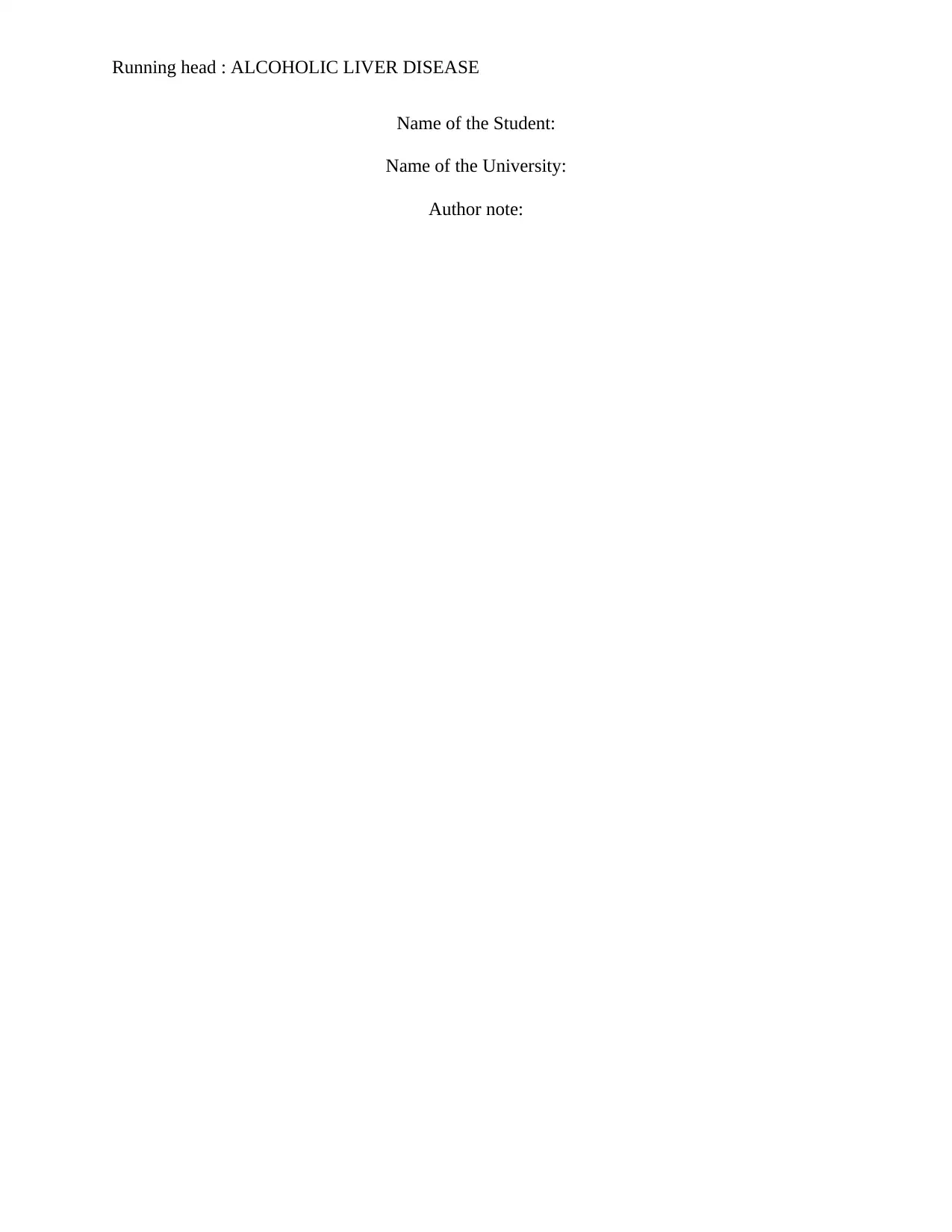
Running head : ALCOHOLIC LIVER DISEASE
Name of the Student:
Name of the University:
Author note:
Name of the Student:
Name of the University:
Author note:
Paraphrase This Document
Need a fresh take? Get an instant paraphrase of this document with our AI Paraphraser
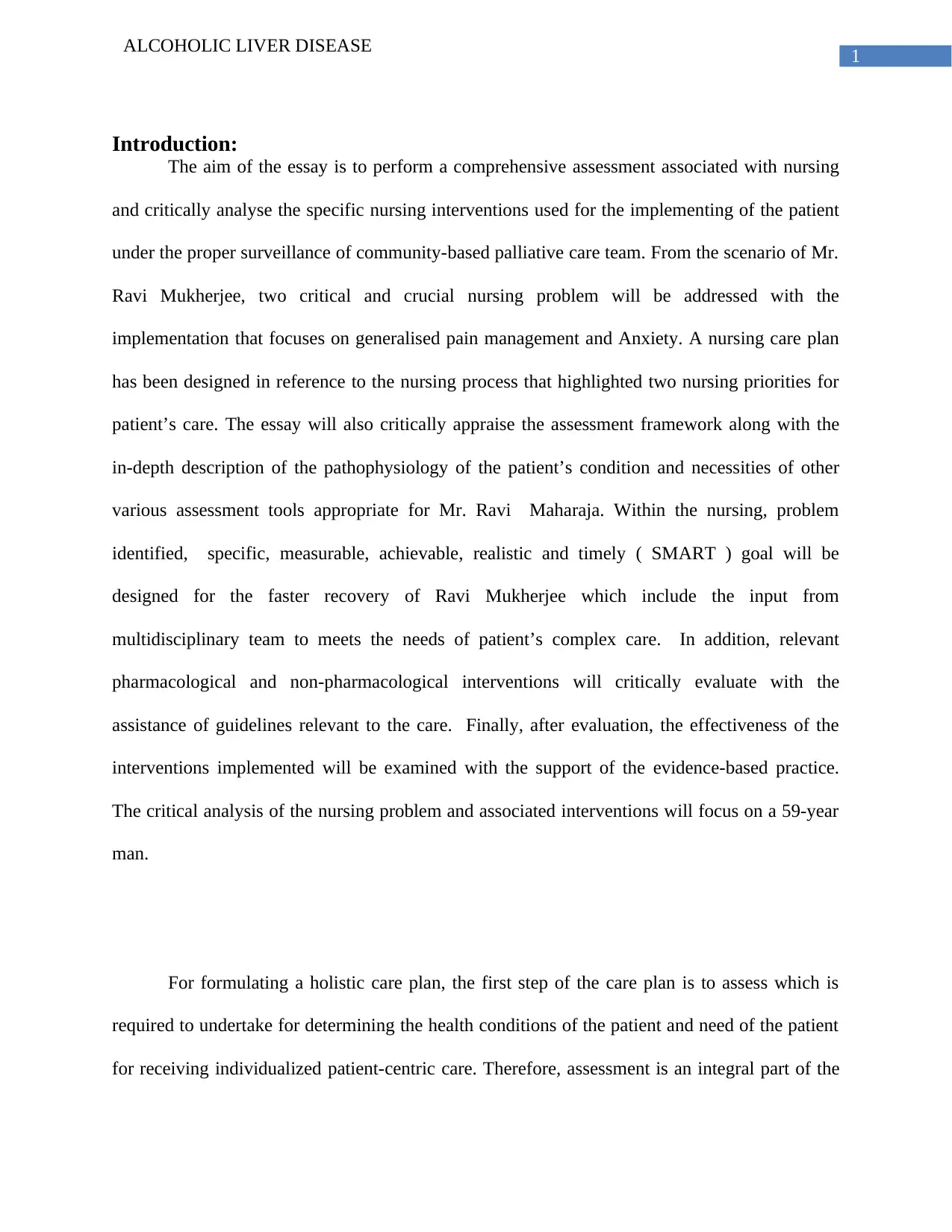
1
ALCOHOLIC LIVER DISEASE
Introduction:
The aim of the essay is to perform a comprehensive assessment associated with nursing
and critically analyse the specific nursing interventions used for the implementing of the patient
under the proper surveillance of community-based palliative care team. From the scenario of Mr.
Ravi Mukherjee, two critical and crucial nursing problem will be addressed with the
implementation that focuses on generalised pain management and Anxiety. A nursing care plan
has been designed in reference to the nursing process that highlighted two nursing priorities for
patient’s care. The essay will also critically appraise the assessment framework along with the
in-depth description of the pathophysiology of the patient’s condition and necessities of other
various assessment tools appropriate for Mr. Ravi Maharaja. Within the nursing, problem
identified, specific, measurable, achievable, realistic and timely ( SMART ) goal will be
designed for the faster recovery of Ravi Mukherjee which include the input from
multidisciplinary team to meets the needs of patient’s complex care. In addition, relevant
pharmacological and non-pharmacological interventions will critically evaluate with the
assistance of guidelines relevant to the care. Finally, after evaluation, the effectiveness of the
interventions implemented will be examined with the support of the evidence-based practice.
The critical analysis of the nursing problem and associated interventions will focus on a 59-year
man.
For formulating a holistic care plan, the first step of the care plan is to assess which is
required to undertake for determining the health conditions of the patient and need of the patient
for receiving individualized patient-centric care. Therefore, assessment is an integral part of the
ALCOHOLIC LIVER DISEASE
Introduction:
The aim of the essay is to perform a comprehensive assessment associated with nursing
and critically analyse the specific nursing interventions used for the implementing of the patient
under the proper surveillance of community-based palliative care team. From the scenario of Mr.
Ravi Mukherjee, two critical and crucial nursing problem will be addressed with the
implementation that focuses on generalised pain management and Anxiety. A nursing care plan
has been designed in reference to the nursing process that highlighted two nursing priorities for
patient’s care. The essay will also critically appraise the assessment framework along with the
in-depth description of the pathophysiology of the patient’s condition and necessities of other
various assessment tools appropriate for Mr. Ravi Maharaja. Within the nursing, problem
identified, specific, measurable, achievable, realistic and timely ( SMART ) goal will be
designed for the faster recovery of Ravi Mukherjee which include the input from
multidisciplinary team to meets the needs of patient’s complex care. In addition, relevant
pharmacological and non-pharmacological interventions will critically evaluate with the
assistance of guidelines relevant to the care. Finally, after evaluation, the effectiveness of the
interventions implemented will be examined with the support of the evidence-based practice.
The critical analysis of the nursing problem and associated interventions will focus on a 59-year
man.
For formulating a holistic care plan, the first step of the care plan is to assess which is
required to undertake for determining the health conditions of the patient and need of the patient
for receiving individualized patient-centric care. Therefore, assessment is an integral part of the
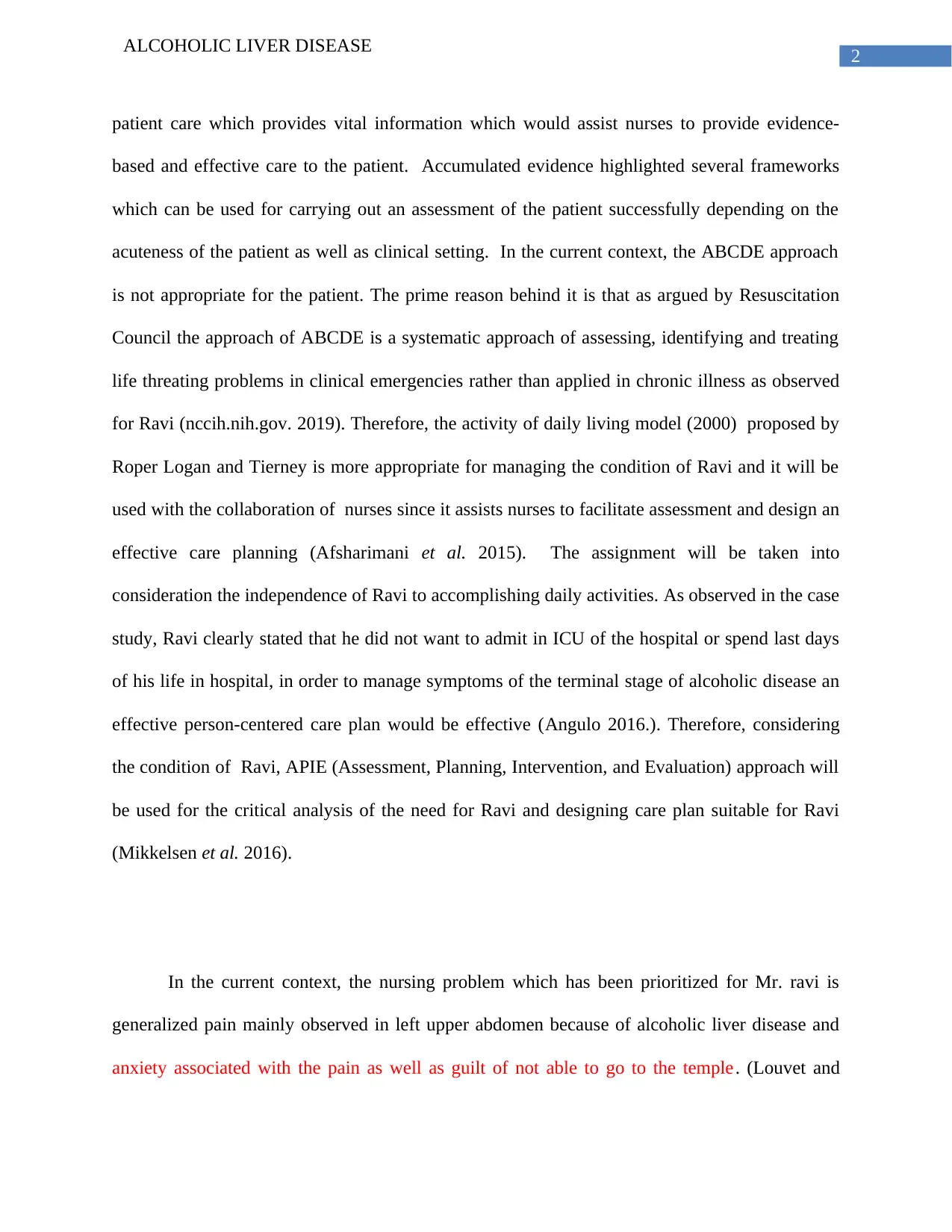
2
ALCOHOLIC LIVER DISEASE
patient care which provides vital information which would assist nurses to provide evidence-
based and effective care to the patient. Accumulated evidence highlighted several frameworks
which can be used for carrying out an assessment of the patient successfully depending on the
acuteness of the patient as well as clinical setting. In the current context, the ABCDE approach
is not appropriate for the patient. The prime reason behind it is that as argued by Resuscitation
Council the approach of ABCDE is a systematic approach of assessing, identifying and treating
life threating problems in clinical emergencies rather than applied in chronic illness as observed
for Ravi (nccih.nih.gov. 2019). Therefore, the activity of daily living model (2000) proposed by
Roper Logan and Tierney is more appropriate for managing the condition of Ravi and it will be
used with the collaboration of nurses since it assists nurses to facilitate assessment and design an
effective care planning (Afsharimani et al. 2015). The assignment will be taken into
consideration the independence of Ravi to accomplishing daily activities. As observed in the case
study, Ravi clearly stated that he did not want to admit in ICU of the hospital or spend last days
of his life in hospital, in order to manage symptoms of the terminal stage of alcoholic disease an
effective person-centered care plan would be effective (Angulo 2016.). Therefore, considering
the condition of Ravi, APIE (Assessment, Planning, Intervention, and Evaluation) approach will
be used for the critical analysis of the need for Ravi and designing care plan suitable for Ravi
(Mikkelsen et al. 2016).
In the current context, the nursing problem which has been prioritized for Mr. ravi is
generalized pain mainly observed in left upper abdomen because of alcoholic liver disease and
anxiety associated with the pain as well as guilt of not able to go to the temple. (Louvet and
ALCOHOLIC LIVER DISEASE
patient care which provides vital information which would assist nurses to provide evidence-
based and effective care to the patient. Accumulated evidence highlighted several frameworks
which can be used for carrying out an assessment of the patient successfully depending on the
acuteness of the patient as well as clinical setting. In the current context, the ABCDE approach
is not appropriate for the patient. The prime reason behind it is that as argued by Resuscitation
Council the approach of ABCDE is a systematic approach of assessing, identifying and treating
life threating problems in clinical emergencies rather than applied in chronic illness as observed
for Ravi (nccih.nih.gov. 2019). Therefore, the activity of daily living model (2000) proposed by
Roper Logan and Tierney is more appropriate for managing the condition of Ravi and it will be
used with the collaboration of nurses since it assists nurses to facilitate assessment and design an
effective care planning (Afsharimani et al. 2015). The assignment will be taken into
consideration the independence of Ravi to accomplishing daily activities. As observed in the case
study, Ravi clearly stated that he did not want to admit in ICU of the hospital or spend last days
of his life in hospital, in order to manage symptoms of the terminal stage of alcoholic disease an
effective person-centered care plan would be effective (Angulo 2016.). Therefore, considering
the condition of Ravi, APIE (Assessment, Planning, Intervention, and Evaluation) approach will
be used for the critical analysis of the need for Ravi and designing care plan suitable for Ravi
(Mikkelsen et al. 2016).
In the current context, the nursing problem which has been prioritized for Mr. ravi is
generalized pain mainly observed in left upper abdomen because of alcoholic liver disease and
anxiety associated with the pain as well as guilt of not able to go to the temple. (Louvet and
⊘ This is a preview!⊘
Do you want full access?
Subscribe today to unlock all pages.

Trusted by 1+ million students worldwide
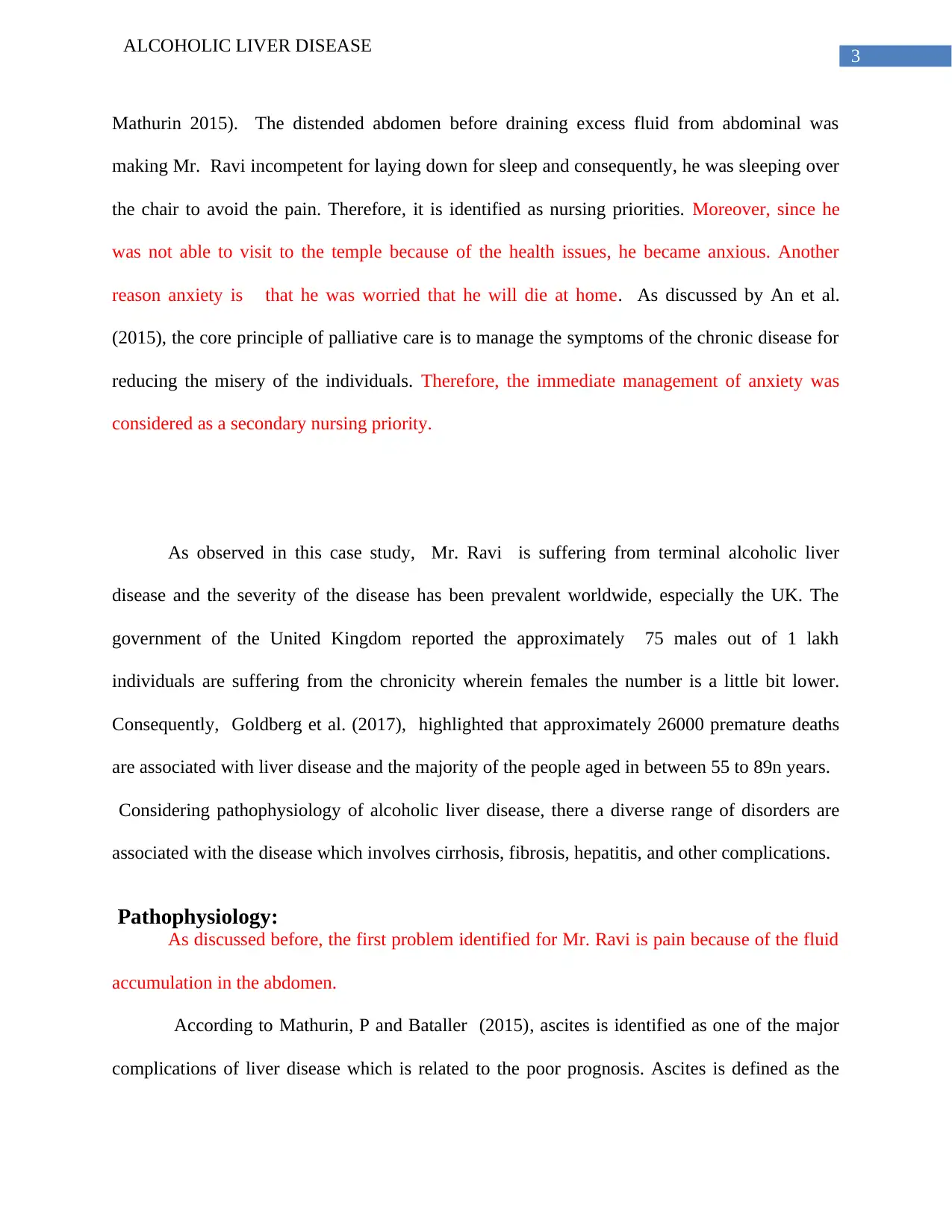
3
ALCOHOLIC LIVER DISEASE
Mathurin 2015). The distended abdomen before draining excess fluid from abdominal was
making Mr. Ravi incompetent for laying down for sleep and consequently, he was sleeping over
the chair to avoid the pain. Therefore, it is identified as nursing priorities. Moreover, since he
was not able to visit to the temple because of the health issues, he became anxious. Another
reason anxiety is that he was worried that he will die at home. As discussed by An et al.
(2015), the core principle of palliative care is to manage the symptoms of the chronic disease for
reducing the misery of the individuals. Therefore, the immediate management of anxiety was
considered as a secondary nursing priority.
As observed in this case study, Mr. Ravi is suffering from terminal alcoholic liver
disease and the severity of the disease has been prevalent worldwide, especially the UK. The
government of the United Kingdom reported the approximately 75 males out of 1 lakh
individuals are suffering from the chronicity wherein females the number is a little bit lower.
Consequently, Goldberg et al. (2017), highlighted that approximately 26000 premature deaths
are associated with liver disease and the majority of the people aged in between 55 to 89n years.
Considering pathophysiology of alcoholic liver disease, there a diverse range of disorders are
associated with the disease which involves cirrhosis, fibrosis, hepatitis, and other complications.
Pathophysiology:
As discussed before, the first problem identified for Mr. Ravi is pain because of the fluid
accumulation in the abdomen.
According to Mathurin, P and Bataller (2015), ascites is identified as one of the major
complications of liver disease which is related to the poor prognosis. Ascites is defined as the
ALCOHOLIC LIVER DISEASE
Mathurin 2015). The distended abdomen before draining excess fluid from abdominal was
making Mr. Ravi incompetent for laying down for sleep and consequently, he was sleeping over
the chair to avoid the pain. Therefore, it is identified as nursing priorities. Moreover, since he
was not able to visit to the temple because of the health issues, he became anxious. Another
reason anxiety is that he was worried that he will die at home. As discussed by An et al.
(2015), the core principle of palliative care is to manage the symptoms of the chronic disease for
reducing the misery of the individuals. Therefore, the immediate management of anxiety was
considered as a secondary nursing priority.
As observed in this case study, Mr. Ravi is suffering from terminal alcoholic liver
disease and the severity of the disease has been prevalent worldwide, especially the UK. The
government of the United Kingdom reported the approximately 75 males out of 1 lakh
individuals are suffering from the chronicity wherein females the number is a little bit lower.
Consequently, Goldberg et al. (2017), highlighted that approximately 26000 premature deaths
are associated with liver disease and the majority of the people aged in between 55 to 89n years.
Considering pathophysiology of alcoholic liver disease, there a diverse range of disorders are
associated with the disease which involves cirrhosis, fibrosis, hepatitis, and other complications.
Pathophysiology:
As discussed before, the first problem identified for Mr. Ravi is pain because of the fluid
accumulation in the abdomen.
According to Mathurin, P and Bataller (2015), ascites is identified as one of the major
complications of liver disease which is related to the poor prognosis. Ascites is defined as the
Paraphrase This Document
Need a fresh take? Get an instant paraphrase of this document with our AI Paraphraser
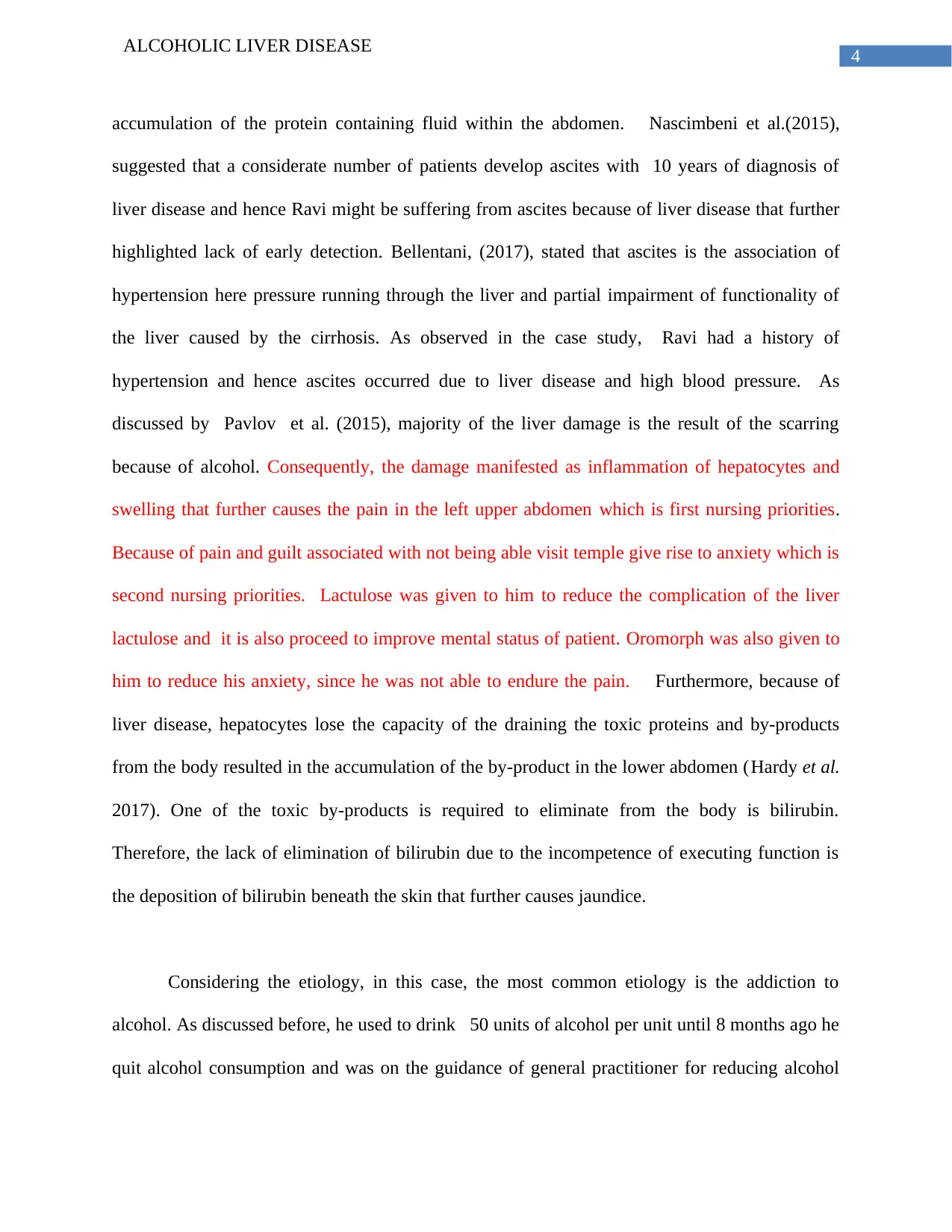
4
ALCOHOLIC LIVER DISEASE
accumulation of the protein containing fluid within the abdomen. Nascimbeni et al.(2015),
suggested that a considerate number of patients develop ascites with 10 years of diagnosis of
liver disease and hence Ravi might be suffering from ascites because of liver disease that further
highlighted lack of early detection. Bellentani, (2017), stated that ascites is the association of
hypertension here pressure running through the liver and partial impairment of functionality of
the liver caused by the cirrhosis. As observed in the case study, Ravi had a history of
hypertension and hence ascites occurred due to liver disease and high blood pressure. As
discussed by Pavlov et al. (2015), majority of the liver damage is the result of the scarring
because of alcohol. Consequently, the damage manifested as inflammation of hepatocytes and
swelling that further causes the pain in the left upper abdomen which is first nursing priorities.
Because of pain and guilt associated with not being able visit temple give rise to anxiety which is
second nursing priorities. Lactulose was given to him to reduce the complication of the liver
lactulose and it is also proceed to improve mental status of patient. Oromorph was also given to
him to reduce his anxiety, since he was not able to endure the pain. Furthermore, because of
liver disease, hepatocytes lose the capacity of the draining the toxic proteins and by-products
from the body resulted in the accumulation of the by-product in the lower abdomen (Hardy et al.
2017). One of the toxic by-products is required to eliminate from the body is bilirubin.
Therefore, the lack of elimination of bilirubin due to the incompetence of executing function is
the deposition of bilirubin beneath the skin that further causes jaundice.
Considering the etiology, in this case, the most common etiology is the addiction to
alcohol. As discussed before, he used to drink 50 units of alcohol per unit until 8 months ago he
quit alcohol consumption and was on the guidance of general practitioner for reducing alcohol
ALCOHOLIC LIVER DISEASE
accumulation of the protein containing fluid within the abdomen. Nascimbeni et al.(2015),
suggested that a considerate number of patients develop ascites with 10 years of diagnosis of
liver disease and hence Ravi might be suffering from ascites because of liver disease that further
highlighted lack of early detection. Bellentani, (2017), stated that ascites is the association of
hypertension here pressure running through the liver and partial impairment of functionality of
the liver caused by the cirrhosis. As observed in the case study, Ravi had a history of
hypertension and hence ascites occurred due to liver disease and high blood pressure. As
discussed by Pavlov et al. (2015), majority of the liver damage is the result of the scarring
because of alcohol. Consequently, the damage manifested as inflammation of hepatocytes and
swelling that further causes the pain in the left upper abdomen which is first nursing priorities.
Because of pain and guilt associated with not being able visit temple give rise to anxiety which is
second nursing priorities. Lactulose was given to him to reduce the complication of the liver
lactulose and it is also proceed to improve mental status of patient. Oromorph was also given to
him to reduce his anxiety, since he was not able to endure the pain. Furthermore, because of
liver disease, hepatocytes lose the capacity of the draining the toxic proteins and by-products
from the body resulted in the accumulation of the by-product in the lower abdomen (Hardy et al.
2017). One of the toxic by-products is required to eliminate from the body is bilirubin.
Therefore, the lack of elimination of bilirubin due to the incompetence of executing function is
the deposition of bilirubin beneath the skin that further causes jaundice.
Considering the etiology, in this case, the most common etiology is the addiction to
alcohol. As discussed before, he used to drink 50 units of alcohol per unit until 8 months ago he
quit alcohol consumption and was on the guidance of general practitioner for reducing alcohol
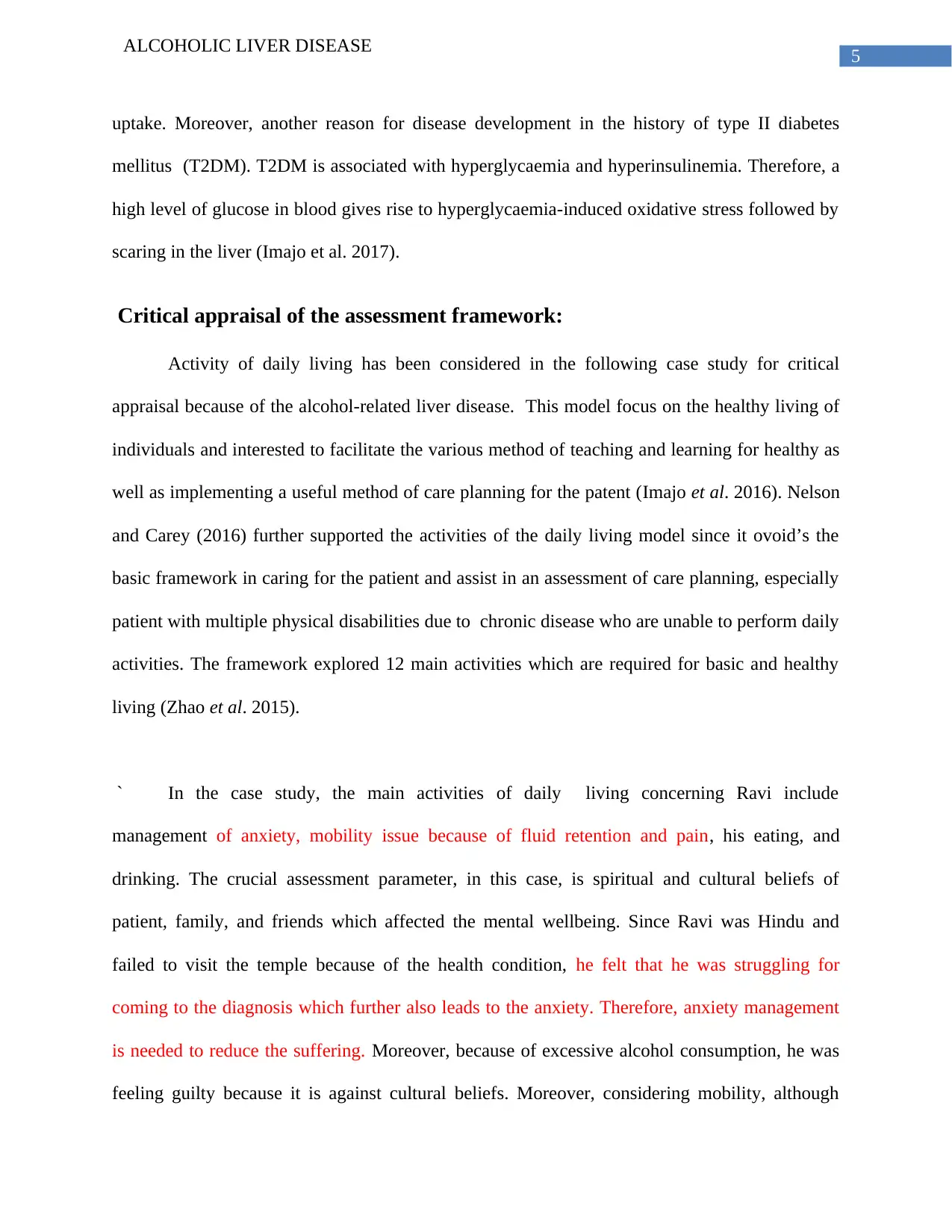
5
ALCOHOLIC LIVER DISEASE
uptake. Moreover, another reason for disease development in the history of type II diabetes
mellitus (T2DM). T2DM is associated with hyperglycaemia and hyperinsulinemia. Therefore, a
high level of glucose in blood gives rise to hyperglycaemia-induced oxidative stress followed by
scaring in the liver (Imajo et al. 2017).
Critical appraisal of the assessment framework:
Activity of daily living has been considered in the following case study for critical
appraisal because of the alcohol-related liver disease. This model focus on the healthy living of
individuals and interested to facilitate the various method of teaching and learning for healthy as
well as implementing a useful method of care planning for the patent (Imajo et al. 2016). Nelson
and Carey (2016) further supported the activities of the daily living model since it ovoid’s the
basic framework in caring for the patient and assist in an assessment of care planning, especially
patient with multiple physical disabilities due to chronic disease who are unable to perform daily
activities. The framework explored 12 main activities which are required for basic and healthy
living (Zhao et al. 2015).
` In the case study, the main activities of daily living concerning Ravi include
management of anxiety, mobility issue because of fluid retention and pain, his eating, and
drinking. The crucial assessment parameter, in this case, is spiritual and cultural beliefs of
patient, family, and friends which affected the mental wellbeing. Since Ravi was Hindu and
failed to visit the temple because of the health condition, he felt that he was struggling for
coming to the diagnosis which further also leads to the anxiety. Therefore, anxiety management
is needed to reduce the suffering. Moreover, because of excessive alcohol consumption, he was
feeling guilty because it is against cultural beliefs. Moreover, considering mobility, although
ALCOHOLIC LIVER DISEASE
uptake. Moreover, another reason for disease development in the history of type II diabetes
mellitus (T2DM). T2DM is associated with hyperglycaemia and hyperinsulinemia. Therefore, a
high level of glucose in blood gives rise to hyperglycaemia-induced oxidative stress followed by
scaring in the liver (Imajo et al. 2017).
Critical appraisal of the assessment framework:
Activity of daily living has been considered in the following case study for critical
appraisal because of the alcohol-related liver disease. This model focus on the healthy living of
individuals and interested to facilitate the various method of teaching and learning for healthy as
well as implementing a useful method of care planning for the patent (Imajo et al. 2016). Nelson
and Carey (2016) further supported the activities of the daily living model since it ovoid’s the
basic framework in caring for the patient and assist in an assessment of care planning, especially
patient with multiple physical disabilities due to chronic disease who are unable to perform daily
activities. The framework explored 12 main activities which are required for basic and healthy
living (Zhao et al. 2015).
` In the case study, the main activities of daily living concerning Ravi include
management of anxiety, mobility issue because of fluid retention and pain, his eating, and
drinking. The crucial assessment parameter, in this case, is spiritual and cultural beliefs of
patient, family, and friends which affected the mental wellbeing. Since Ravi was Hindu and
failed to visit the temple because of the health condition, he felt that he was struggling for
coming to the diagnosis which further also leads to the anxiety. Therefore, anxiety management
is needed to reduce the suffering. Moreover, because of excessive alcohol consumption, he was
feeling guilty because it is against cultural beliefs. Moreover, considering mobility, although
⊘ This is a preview!⊘
Do you want full access?
Subscribe today to unlock all pages.

Trusted by 1+ million students worldwide
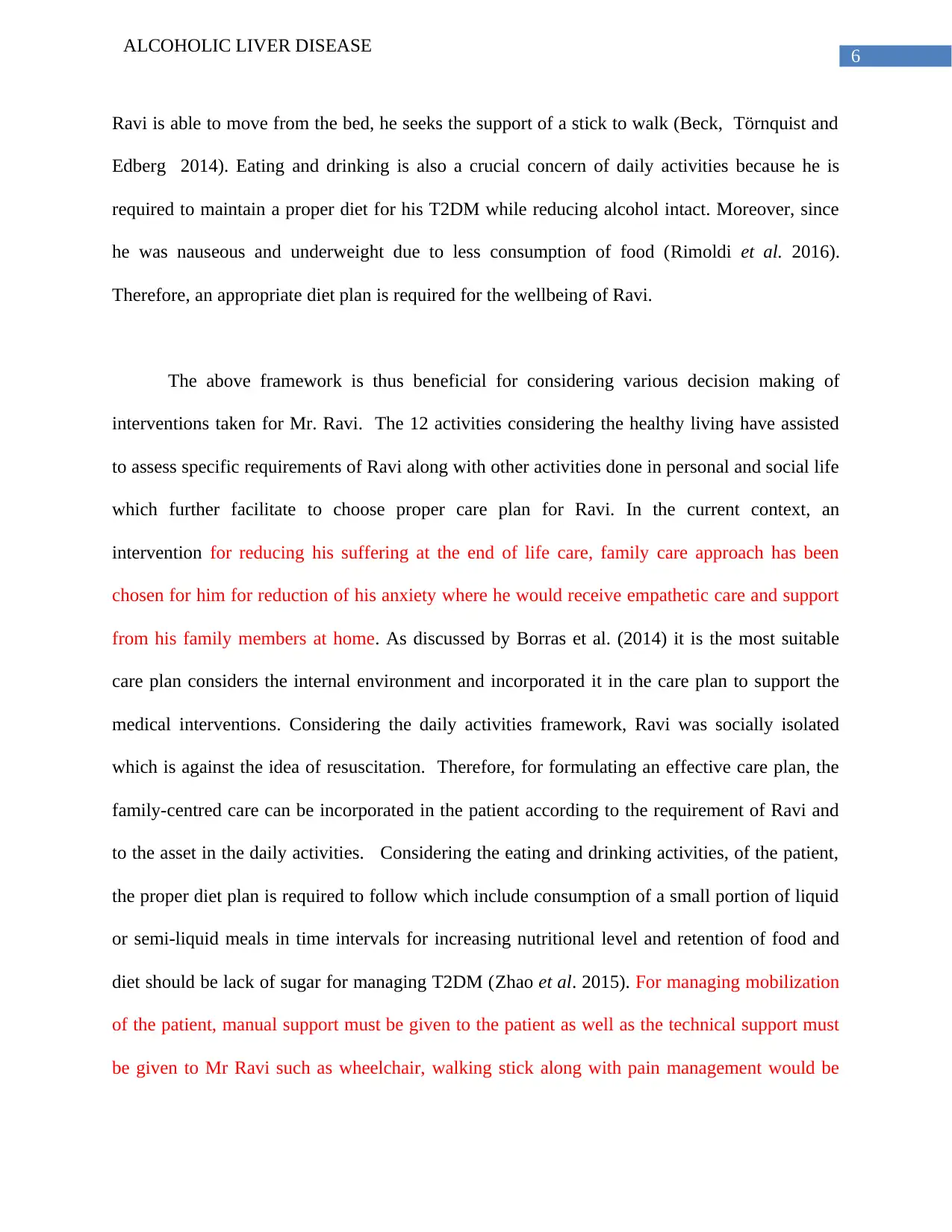
6
ALCOHOLIC LIVER DISEASE
Ravi is able to move from the bed, he seeks the support of a stick to walk (Beck, Törnquist and
Edberg 2014). Eating and drinking is also a crucial concern of daily activities because he is
required to maintain a proper diet for his T2DM while reducing alcohol intact. Moreover, since
he was nauseous and underweight due to less consumption of food (Rimoldi et al. 2016).
Therefore, an appropriate diet plan is required for the wellbeing of Ravi.
The above framework is thus beneficial for considering various decision making of
interventions taken for Mr. Ravi. The 12 activities considering the healthy living have assisted
to assess specific requirements of Ravi along with other activities done in personal and social life
which further facilitate to choose proper care plan for Ravi. In the current context, an
intervention for reducing his suffering at the end of life care, family care approach has been
chosen for him for reduction of his anxiety where he would receive empathetic care and support
from his family members at home. As discussed by Borras et al. (2014) it is the most suitable
care plan considers the internal environment and incorporated it in the care plan to support the
medical interventions. Considering the daily activities framework, Ravi was socially isolated
which is against the idea of resuscitation. Therefore, for formulating an effective care plan, the
family-centred care can be incorporated in the patient according to the requirement of Ravi and
to the asset in the daily activities. Considering the eating and drinking activities, of the patient,
the proper diet plan is required to follow which include consumption of a small portion of liquid
or semi-liquid meals in time intervals for increasing nutritional level and retention of food and
diet should be lack of sugar for managing T2DM (Zhao et al. 2015). For managing mobilization
of the patient, manual support must be given to the patient as well as the technical support must
be given to Mr Ravi such as wheelchair, walking stick along with pain management would be
ALCOHOLIC LIVER DISEASE
Ravi is able to move from the bed, he seeks the support of a stick to walk (Beck, Törnquist and
Edberg 2014). Eating and drinking is also a crucial concern of daily activities because he is
required to maintain a proper diet for his T2DM while reducing alcohol intact. Moreover, since
he was nauseous and underweight due to less consumption of food (Rimoldi et al. 2016).
Therefore, an appropriate diet plan is required for the wellbeing of Ravi.
The above framework is thus beneficial for considering various decision making of
interventions taken for Mr. Ravi. The 12 activities considering the healthy living have assisted
to assess specific requirements of Ravi along with other activities done in personal and social life
which further facilitate to choose proper care plan for Ravi. In the current context, an
intervention for reducing his suffering at the end of life care, family care approach has been
chosen for him for reduction of his anxiety where he would receive empathetic care and support
from his family members at home. As discussed by Borras et al. (2014) it is the most suitable
care plan considers the internal environment and incorporated it in the care plan to support the
medical interventions. Considering the daily activities framework, Ravi was socially isolated
which is against the idea of resuscitation. Therefore, for formulating an effective care plan, the
family-centred care can be incorporated in the patient according to the requirement of Ravi and
to the asset in the daily activities. Considering the eating and drinking activities, of the patient,
the proper diet plan is required to follow which include consumption of a small portion of liquid
or semi-liquid meals in time intervals for increasing nutritional level and retention of food and
diet should be lack of sugar for managing T2DM (Zhao et al. 2015). For managing mobilization
of the patient, manual support must be given to the patient as well as the technical support must
be given to Mr Ravi such as wheelchair, walking stick along with pain management would be
Paraphrase This Document
Need a fresh take? Get an instant paraphrase of this document with our AI Paraphraser
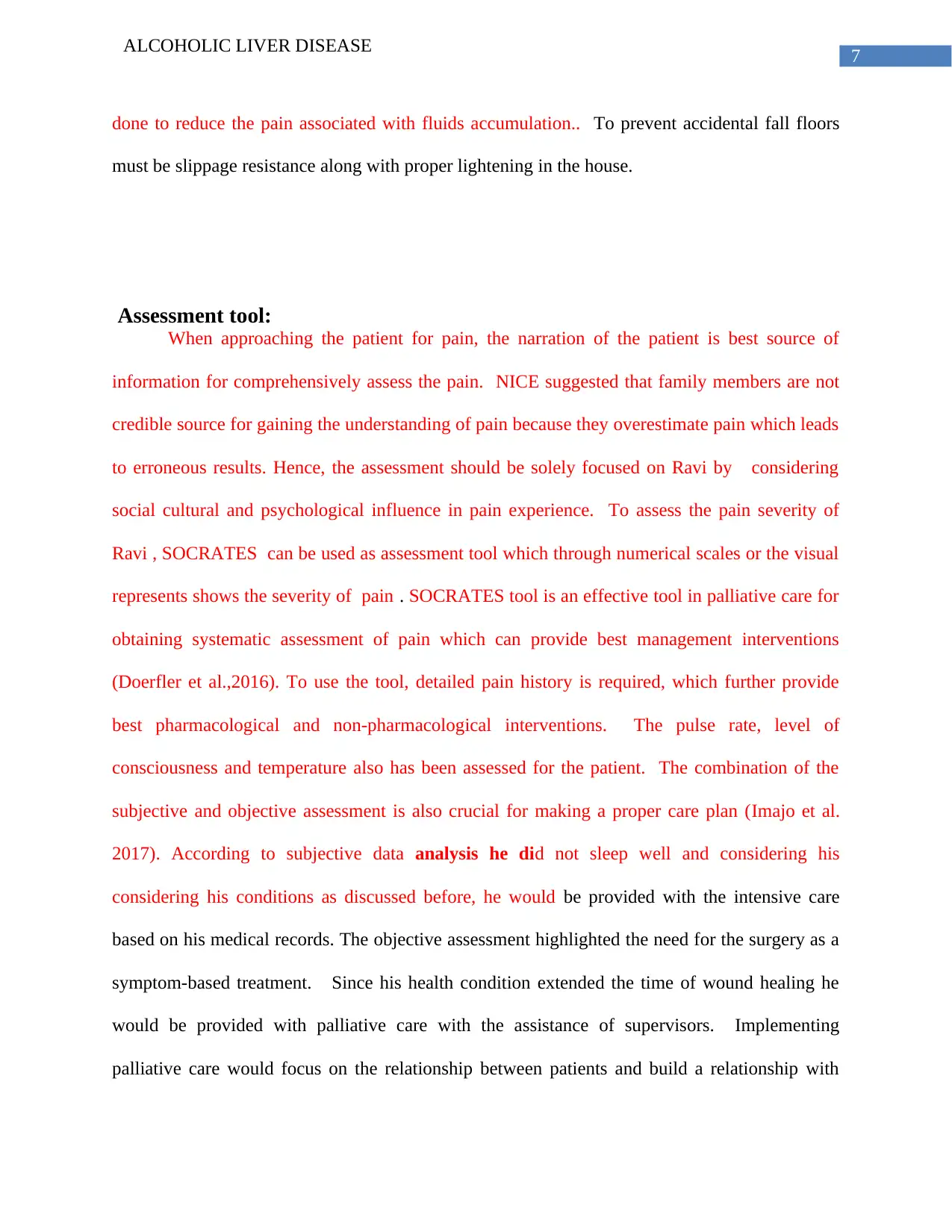
7
ALCOHOLIC LIVER DISEASE
done to reduce the pain associated with fluids accumulation.. To prevent accidental fall floors
must be slippage resistance along with proper lightening in the house.
Assessment tool:
When approaching the patient for pain, the narration of the patient is best source of
information for comprehensively assess the pain. NICE suggested that family members are not
credible source for gaining the understanding of pain because they overestimate pain which leads
to erroneous results. Hence, the assessment should be solely focused on Ravi by considering
social cultural and psychological influence in pain experience. To assess the pain severity of
Ravi , SOCRATES can be used as assessment tool which through numerical scales or the visual
represents shows the severity of pain . SOCRATES tool is an effective tool in palliative care for
obtaining systematic assessment of pain which can provide best management interventions
(Doerfler et al.,2016). To use the tool, detailed pain history is required, which further provide
best pharmacological and non-pharmacological interventions. The pulse rate, level of
consciousness and temperature also has been assessed for the patient. The combination of the
subjective and objective assessment is also crucial for making a proper care plan (Imajo et al.
2017). According to subjective data analysis he did not sleep well and considering his
considering his conditions as discussed before, he would be provided with the intensive care
based on his medical records. The objective assessment highlighted the need for the surgery as a
symptom-based treatment. Since his health condition extended the time of wound healing he
would be provided with palliative care with the assistance of supervisors. Implementing
palliative care would focus on the relationship between patients and build a relationship with
ALCOHOLIC LIVER DISEASE
done to reduce the pain associated with fluids accumulation.. To prevent accidental fall floors
must be slippage resistance along with proper lightening in the house.
Assessment tool:
When approaching the patient for pain, the narration of the patient is best source of
information for comprehensively assess the pain. NICE suggested that family members are not
credible source for gaining the understanding of pain because they overestimate pain which leads
to erroneous results. Hence, the assessment should be solely focused on Ravi by considering
social cultural and psychological influence in pain experience. To assess the pain severity of
Ravi , SOCRATES can be used as assessment tool which through numerical scales or the visual
represents shows the severity of pain . SOCRATES tool is an effective tool in palliative care for
obtaining systematic assessment of pain which can provide best management interventions
(Doerfler et al.,2016). To use the tool, detailed pain history is required, which further provide
best pharmacological and non-pharmacological interventions. The pulse rate, level of
consciousness and temperature also has been assessed for the patient. The combination of the
subjective and objective assessment is also crucial for making a proper care plan (Imajo et al.
2017). According to subjective data analysis he did not sleep well and considering his
considering his conditions as discussed before, he would be provided with the intensive care
based on his medical records. The objective assessment highlighted the need for the surgery as a
symptom-based treatment. Since his health condition extended the time of wound healing he
would be provided with palliative care with the assistance of supervisors. Implementing
palliative care would focus on the relationship between patients and build a relationship with
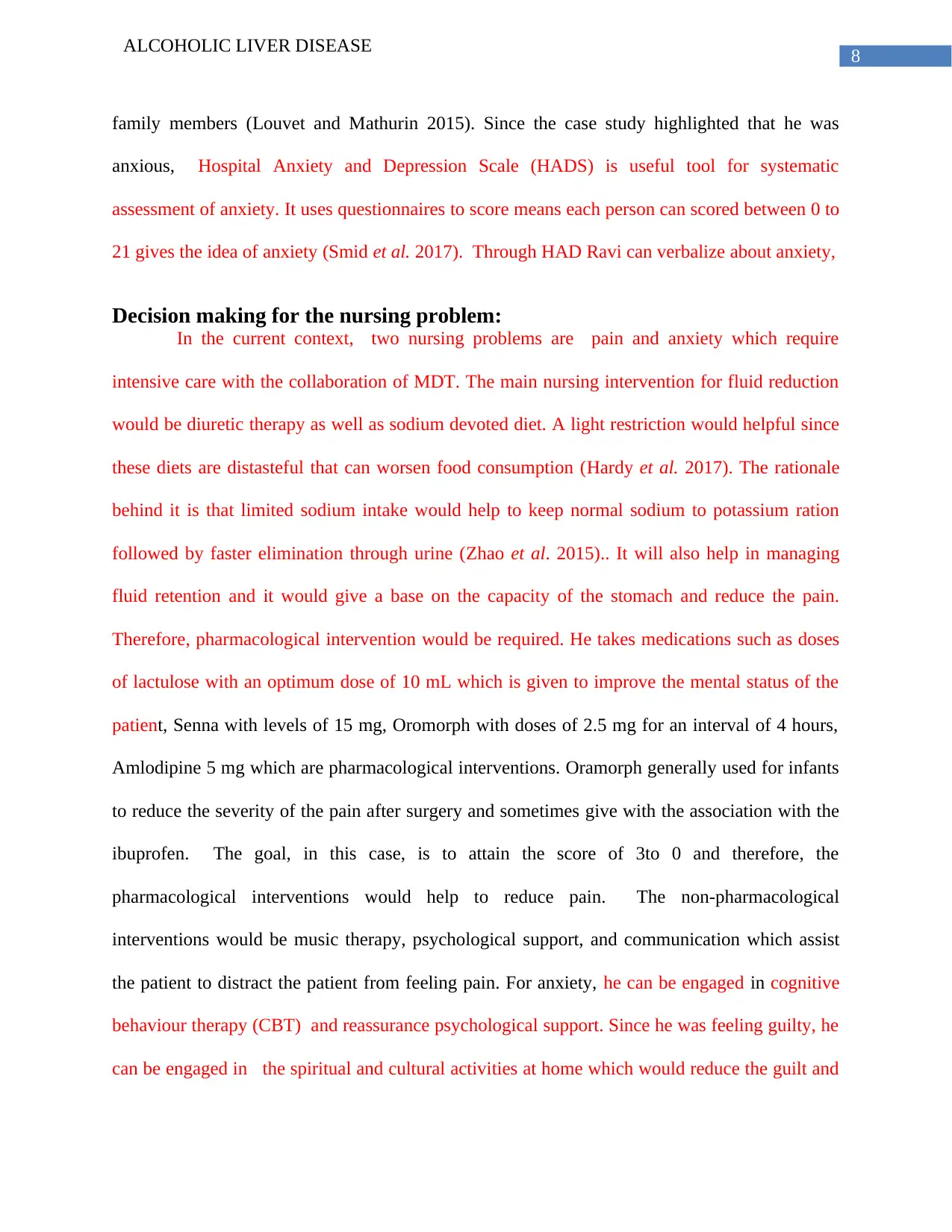
8
ALCOHOLIC LIVER DISEASE
family members (Louvet and Mathurin 2015). Since the case study highlighted that he was
anxious, Hospital Anxiety and Depression Scale (HADS) is useful tool for systematic
assessment of anxiety. It uses questionnaires to score means each person can scored between 0 to
21 gives the idea of anxiety (Smid et al. 2017). Through HAD Ravi can verbalize about anxiety,
Decision making for the nursing problem:
In the current context, two nursing problems are pain and anxiety which require
intensive care with the collaboration of MDT. The main nursing intervention for fluid reduction
would be diuretic therapy as well as sodium devoted diet. A light restriction would helpful since
these diets are distasteful that can worsen food consumption (Hardy et al. 2017). The rationale
behind it is that limited sodium intake would help to keep normal sodium to potassium ration
followed by faster elimination through urine (Zhao et al. 2015).. It will also help in managing
fluid retention and it would give a base on the capacity of the stomach and reduce the pain.
Therefore, pharmacological intervention would be required. He takes medications such as doses
of lactulose with an optimum dose of 10 mL which is given to improve the mental status of the
patient, Senna with levels of 15 mg, Oromorph with doses of 2.5 mg for an interval of 4 hours,
Amlodipine 5 mg which are pharmacological interventions. Oramorph generally used for infants
to reduce the severity of the pain after surgery and sometimes give with the association with the
ibuprofen. The goal, in this case, is to attain the score of 3to 0 and therefore, the
pharmacological interventions would help to reduce pain. The non-pharmacological
interventions would be music therapy, psychological support, and communication which assist
the patient to distract the patient from feeling pain. For anxiety, he can be engaged in cognitive
behaviour therapy (CBT) and reassurance psychological support. Since he was feeling guilty, he
can be engaged in the spiritual and cultural activities at home which would reduce the guilt and
ALCOHOLIC LIVER DISEASE
family members (Louvet and Mathurin 2015). Since the case study highlighted that he was
anxious, Hospital Anxiety and Depression Scale (HADS) is useful tool for systematic
assessment of anxiety. It uses questionnaires to score means each person can scored between 0 to
21 gives the idea of anxiety (Smid et al. 2017). Through HAD Ravi can verbalize about anxiety,
Decision making for the nursing problem:
In the current context, two nursing problems are pain and anxiety which require
intensive care with the collaboration of MDT. The main nursing intervention for fluid reduction
would be diuretic therapy as well as sodium devoted diet. A light restriction would helpful since
these diets are distasteful that can worsen food consumption (Hardy et al. 2017). The rationale
behind it is that limited sodium intake would help to keep normal sodium to potassium ration
followed by faster elimination through urine (Zhao et al. 2015).. It will also help in managing
fluid retention and it would give a base on the capacity of the stomach and reduce the pain.
Therefore, pharmacological intervention would be required. He takes medications such as doses
of lactulose with an optimum dose of 10 mL which is given to improve the mental status of the
patient, Senna with levels of 15 mg, Oromorph with doses of 2.5 mg for an interval of 4 hours,
Amlodipine 5 mg which are pharmacological interventions. Oramorph generally used for infants
to reduce the severity of the pain after surgery and sometimes give with the association with the
ibuprofen. The goal, in this case, is to attain the score of 3to 0 and therefore, the
pharmacological interventions would help to reduce pain. The non-pharmacological
interventions would be music therapy, psychological support, and communication which assist
the patient to distract the patient from feeling pain. For anxiety, he can be engaged in cognitive
behaviour therapy (CBT) and reassurance psychological support. Since he was feeling guilty, he
can be engaged in the spiritual and cultural activities at home which would reduce the guilt and
⊘ This is a preview!⊘
Do you want full access?
Subscribe today to unlock all pages.

Trusted by 1+ million students worldwide
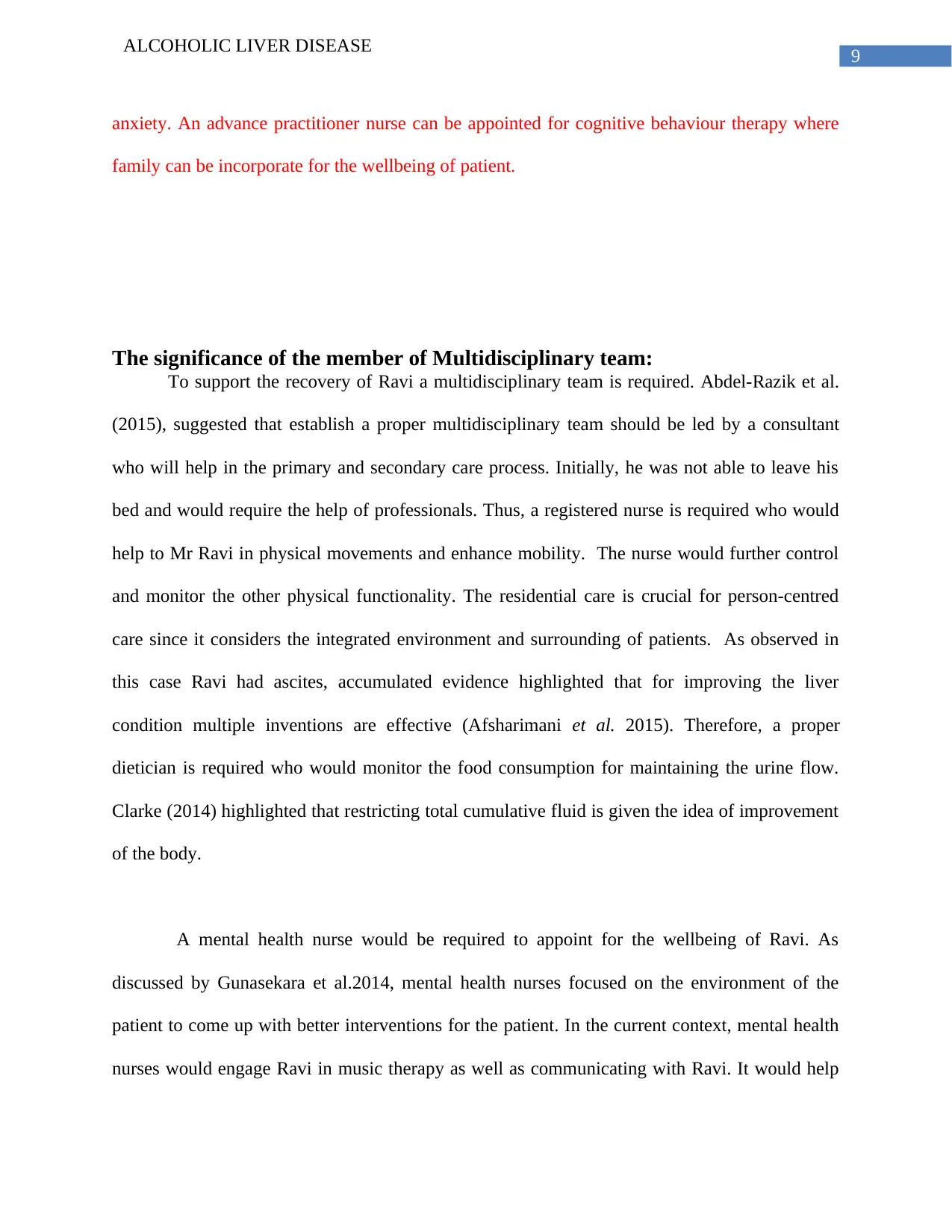
9
ALCOHOLIC LIVER DISEASE
anxiety. An advance practitioner nurse can be appointed for cognitive behaviour therapy where
family can be incorporate for the wellbeing of patient.
The significance of the member of Multidisciplinary team:
To support the recovery of Ravi a multidisciplinary team is required. Abdel-Razik et al.
(2015), suggested that establish a proper multidisciplinary team should be led by a consultant
who will help in the primary and secondary care process. Initially, he was not able to leave his
bed and would require the help of professionals. Thus, a registered nurse is required who would
help to Mr Ravi in physical movements and enhance mobility. The nurse would further control
and monitor the other physical functionality. The residential care is crucial for person-centred
care since it considers the integrated environment and surrounding of patients. As observed in
this case Ravi had ascites, accumulated evidence highlighted that for improving the liver
condition multiple inventions are effective (Afsharimani et al. 2015). Therefore, a proper
dietician is required who would monitor the food consumption for maintaining the urine flow.
Clarke (2014) highlighted that restricting total cumulative fluid is given the idea of improvement
of the body.
A mental health nurse would be required to appoint for the wellbeing of Ravi. As
discussed by Gunasekara et al.2014, mental health nurses focused on the environment of the
patient to come up with better interventions for the patient. In the current context, mental health
nurses would engage Ravi in music therapy as well as communicating with Ravi. It would help
ALCOHOLIC LIVER DISEASE
anxiety. An advance practitioner nurse can be appointed for cognitive behaviour therapy where
family can be incorporate for the wellbeing of patient.
The significance of the member of Multidisciplinary team:
To support the recovery of Ravi a multidisciplinary team is required. Abdel-Razik et al.
(2015), suggested that establish a proper multidisciplinary team should be led by a consultant
who will help in the primary and secondary care process. Initially, he was not able to leave his
bed and would require the help of professionals. Thus, a registered nurse is required who would
help to Mr Ravi in physical movements and enhance mobility. The nurse would further control
and monitor the other physical functionality. The residential care is crucial for person-centred
care since it considers the integrated environment and surrounding of patients. As observed in
this case Ravi had ascites, accumulated evidence highlighted that for improving the liver
condition multiple inventions are effective (Afsharimani et al. 2015). Therefore, a proper
dietician is required who would monitor the food consumption for maintaining the urine flow.
Clarke (2014) highlighted that restricting total cumulative fluid is given the idea of improvement
of the body.
A mental health nurse would be required to appoint for the wellbeing of Ravi. As
discussed by Gunasekara et al.2014, mental health nurses focused on the environment of the
patient to come up with better interventions for the patient. In the current context, mental health
nurses would engage Ravi in music therapy as well as communicating with Ravi. It would help
Paraphrase This Document
Need a fresh take? Get an instant paraphrase of this document with our AI Paraphraser
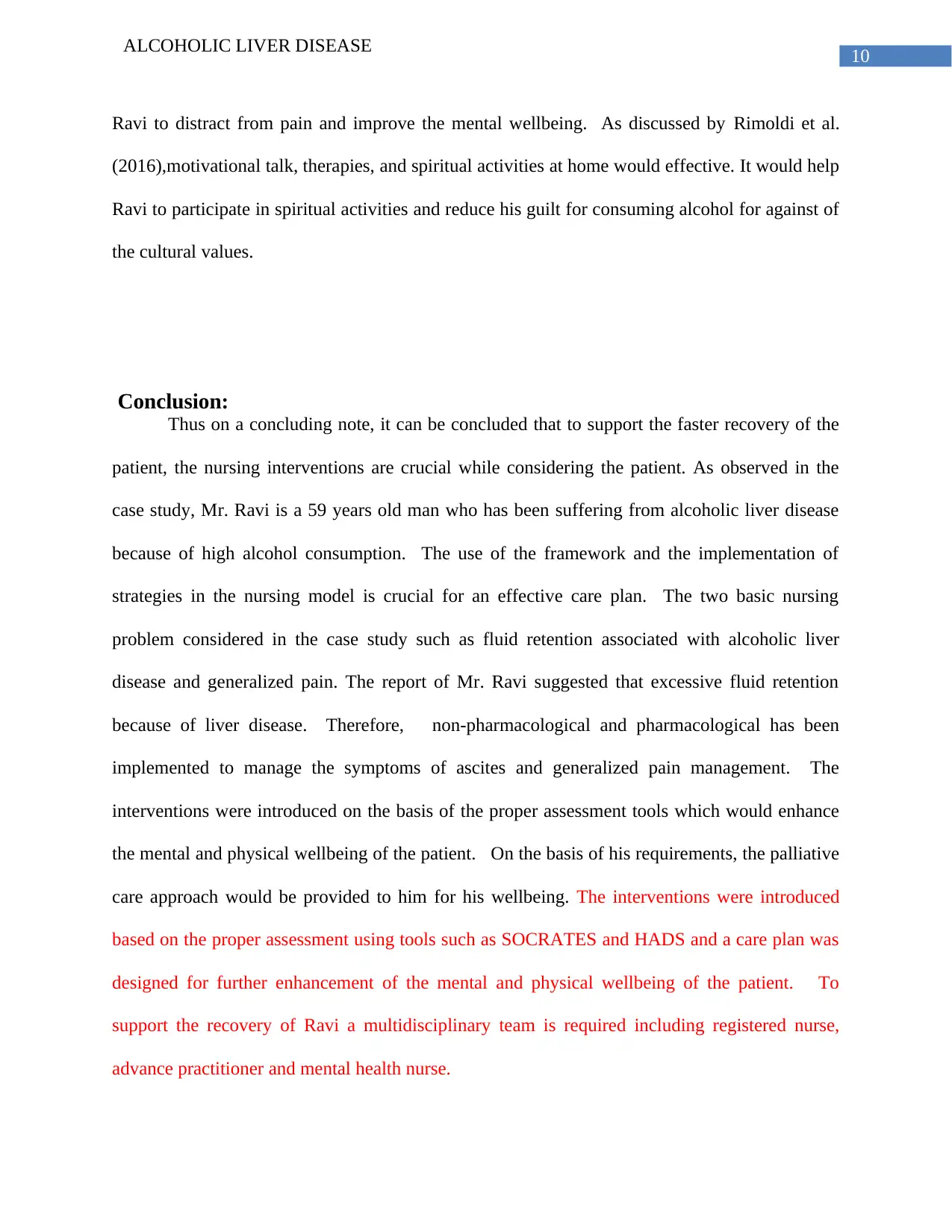
10
ALCOHOLIC LIVER DISEASE
Ravi to distract from pain and improve the mental wellbeing. As discussed by Rimoldi et al.
(2016),motivational talk, therapies, and spiritual activities at home would effective. It would help
Ravi to participate in spiritual activities and reduce his guilt for consuming alcohol for against of
the cultural values.
Conclusion:
Thus on a concluding note, it can be concluded that to support the faster recovery of the
patient, the nursing interventions are crucial while considering the patient. As observed in the
case study, Mr. Ravi is a 59 years old man who has been suffering from alcoholic liver disease
because of high alcohol consumption. The use of the framework and the implementation of
strategies in the nursing model is crucial for an effective care plan. The two basic nursing
problem considered in the case study such as fluid retention associated with alcoholic liver
disease and generalized pain. The report of Mr. Ravi suggested that excessive fluid retention
because of liver disease. Therefore, non-pharmacological and pharmacological has been
implemented to manage the symptoms of ascites and generalized pain management. The
interventions were introduced on the basis of the proper assessment tools which would enhance
the mental and physical wellbeing of the patient. On the basis of his requirements, the palliative
care approach would be provided to him for his wellbeing. The interventions were introduced
based on the proper assessment using tools such as SOCRATES and HADS and a care plan was
designed for further enhancement of the mental and physical wellbeing of the patient. To
support the recovery of Ravi a multidisciplinary team is required including registered nurse,
advance practitioner and mental health nurse.
ALCOHOLIC LIVER DISEASE
Ravi to distract from pain and improve the mental wellbeing. As discussed by Rimoldi et al.
(2016),motivational talk, therapies, and spiritual activities at home would effective. It would help
Ravi to participate in spiritual activities and reduce his guilt for consuming alcohol for against of
the cultural values.
Conclusion:
Thus on a concluding note, it can be concluded that to support the faster recovery of the
patient, the nursing interventions are crucial while considering the patient. As observed in the
case study, Mr. Ravi is a 59 years old man who has been suffering from alcoholic liver disease
because of high alcohol consumption. The use of the framework and the implementation of
strategies in the nursing model is crucial for an effective care plan. The two basic nursing
problem considered in the case study such as fluid retention associated with alcoholic liver
disease and generalized pain. The report of Mr. Ravi suggested that excessive fluid retention
because of liver disease. Therefore, non-pharmacological and pharmacological has been
implemented to manage the symptoms of ascites and generalized pain management. The
interventions were introduced on the basis of the proper assessment tools which would enhance
the mental and physical wellbeing of the patient. On the basis of his requirements, the palliative
care approach would be provided to him for his wellbeing. The interventions were introduced
based on the proper assessment using tools such as SOCRATES and HADS and a care plan was
designed for further enhancement of the mental and physical wellbeing of the patient. To
support the recovery of Ravi a multidisciplinary team is required including registered nurse,
advance practitioner and mental health nurse.

11
ALCOHOLIC LIVER DISEASE
ALCOHOLIC LIVER DISEASE
⊘ This is a preview!⊘
Do you want full access?
Subscribe today to unlock all pages.

Trusted by 1+ million students worldwide
1 out of 26
Related Documents
Your All-in-One AI-Powered Toolkit for Academic Success.
+13062052269
info@desklib.com
Available 24*7 on WhatsApp / Email
![[object Object]](/_next/static/media/star-bottom.7253800d.svg)
Unlock your academic potential
Copyright © 2020–2025 A2Z Services. All Rights Reserved. Developed and managed by ZUCOL.





